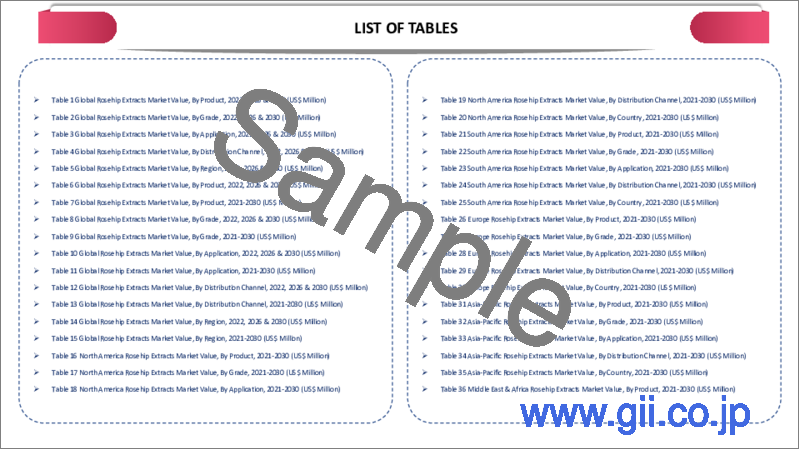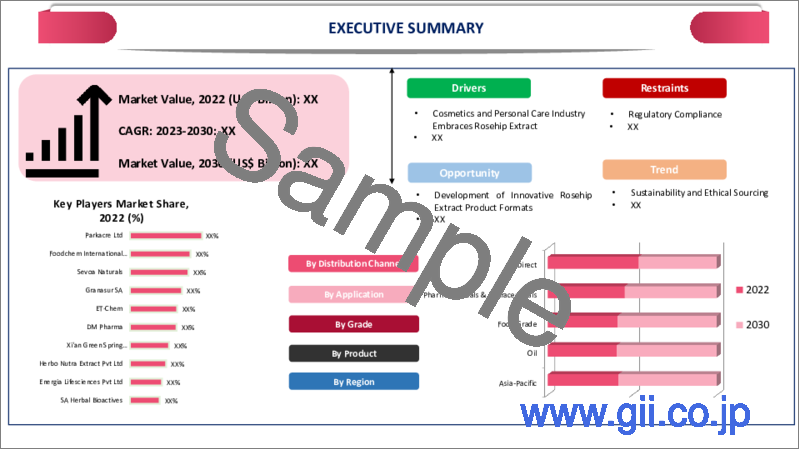|
|
市場調査レポート
商品コード
1169034
ローズヒップエキスの世界市場-2022-2029Global Rosehip Extracts Market - 2022-2029 |
||||||
|
● お客様のご希望に応じて、既存データの加工や未掲載情報(例:国別セグメント)の追加などの対応が可能です。 詳細はお問い合わせください。 |
|||||||
| ローズヒップエキスの世界市場-2022-2029 |
|
出版日: 2022年12月08日
発行: DataM Intelligence
ページ情報: 英文 171 Pages
納期: 約2営業日
|
- 全表示
- 概要
- 目次
市場概要
ローズヒップはバラ科に属する生薬です。別名Rosa caninaといい、欧州、アフリカ、アジアの一部の地域に生息する野バラの一種です。ローズヒップは、基本的にバラ科の植物が受精した後、夏の終わりから秋にかけてできる果実です。ローズヒップは、バラ科植物の種子を含んでいます。このバラの種子と乾燥したヒップを粉砕し、混合したものがローズヒップエキスです。新鮮なローズヒップにはビタミンCが豊富に含まれており、インフルエンザや風邪、ビタミンCの欠乏症の治療に役立ちます。
ローズヒップエキスは、飲食品産業においても、お茶、ジャム、スープ、パイ、パンなど、様々な製品の調製に使用されています。さらに、ローズヒップエキスは、抗酸化作用や抗炎症作用のあるハーブ治療にも使用されています。ローズヒップエキスから作られた医薬品は、皮膚疾患の治療、骨の健康、低コレステロール、スキンケア、免疫システムの改善など、いくつかの健康上の利点があるため、がん、関節リウマチ、肥満などの病気の治療のために市販されています。
したがって、ローズヒップエキスは、胃酸不足、胃痙攣、胃の炎症や潰瘍の予防、腸の病気のための胃の強壮剤としてなどの胃の関連疾患に適しています。
世界のローズヒップエキス市場は、予測期間(2022年~2029年)にCAGR8.97%で成長すると予測されています。
市場力学:化粧品およびパーソナルケア業界における植物エキスの導入が増加
化粧品、コスメシューティカル、パーソナルケア製品における植物性エキスの一貫した使用が、市場の成長を促進しています。化粧品やパーソナルケア製品におけるローズヒップエキスなどの植物性エキスの需要を高めている要因は様々で、化粧品処方における天然植物ベースのエキスの使用に対する消費者の注目と魅力が高まっているためであると考えられます。また、消費者の需要や好みに加えて、消費者は肌に塗る美容製品の背後にある成分を深く気にするようになっており、合成添加物は安全性が低く、長期間の使用には適していないと認識されています。
さらに、植物エキスには、フラボノイド、ポリフェノール、多糖類、ビタミンなど、天然の強力な美肌効果や皮膚保護効果があります。例えば、ローズヒップ・エキスには、ポリフェノールやアントシアニンが含まれており、関節の炎症を和らげ、関節の損傷を防ぐと考えられています。また、抗酸化作用のあるビタミンCも豊富に含まれています。このように、複数の利点は、しばしば単一の抽出物内で同時に発生し、ローズヒップエキス市場の成長に追加する合成成分よりも巨大な付加価値を提供します。したがって、メーカーも消費者の要求を満たすために、市場に新製品を投入しています。例えば、2020年にLaunchoraは、化粧品やパーソナルケア業界向けのオーガニックローズヒップオイルを発売しました。
市場のセグメンテーション:ローズヒップエキスの世界市場において、化粧品が最も高いシェアを占めています
2021年、化粧品分野の売上高シェアはYYパーセントと最も高かったです。化粧品業界では、天然素材や植物由来の製品の使用が増加しているため、ローズヒップエキスなどの植物性エキスの市場需要が高まっています。また、ローズヒップエキスの皮膚や髪への化粧品用途は、アンチエイジングや抗炎症の効果でよく知られています。さらに、ビタミンC(アスコルビン酸)やポリフェノールを含むその他の抗酸化化合物を多く含み、優れた抗酸化プロファイルを示すことから、肌や髪の保護、若返り、ハリ、鎮静、調整、強化などを目的とした多くの化粧品製剤や処方の強化に使用されているのです。例えば、New Directions Aromaticsによると、2020年には、スキンケア製品にローズヒップエキスを加えることで、肌の弾力性の向上、くすみや変色した顔色の改善、環境汚染物質や紫外線に対する肌の保護に貢献することができるとされています。
地域別浸透度:予測期間中、アジア太平洋地域が圧倒的なシェアを占める
2021年の売上シェアは、アジア太平洋がYYパーセントと最も高かったです。中国、日本、インドなどの新興経済諸国では、肌に敏感な顧客が増加しており、市場でのローズヒップエキスの需要が増加しています。また、インドでは皮膚に関する問題が増加していることが、市場の収益成長を促進しています。例えば、2020年、Indian Journal of Dermatology, Venereology and Leprologyによると、2017年のインドにおける皮膚および皮下疾患はYLD全体の4.02 %を占め、インドにおける皮膚疾患の負担には、皮膚炎、じんましん、ニキビが大きく寄与しています。しかし、真菌性皮膚疾患12.6%、ウイルス性皮膚疾患-10.0%、疥癬-10.3%など、感染症や蔓延も皮膚・皮下疾患によるYLD全体の30%近くを占めています。このように、皮膚の問題が増加したことで、消費者はローズヒップエキスなどの天然物を使用して皮膚のケアをすることが可能になり、この地域の市場の成長を促進しています。
目次
第1章 調査手法と範囲
- 調査手法
- 市場の範囲
第2章 主な動向と発展
第3章 エグゼクティブサマリー
- 製品タイプ別市場内訳
- アプリケーション別市場内訳
- 地域別市場内訳
第4章 市場力学
- 市場影響要因
- 促進要因
- 抑制要因
- ビジネスチャンス
- 影響分析
第5章 産業分析
- ポーターのファイブフォース分析
- バリューチェーン分析
- 規制分析
- サプライチェーン分析
第6章 COVID-19の分析
- COVID-19の市場分析
- COVID-19以前の市場シナリオ
- COVID-19の現在の市場シナリオ
- COVID-19の後、または将来のシナリオ
- COVID-19の中での価格ダイナミクス
- 需要-供給スペクトラム
- パンデミック時の市場に関連する政府の取り組み
- メーカーの戦略的な取り組み
第7章 製品タイプ別
- オイル
- パウダー
第8章 用途別
- 飲食品
- 医薬品
- 化粧品
第9章 地域別
- 北米
- 米国
- カナダ
- メキシコ
- 南米
- ブラジル
- アルゼンチン
- その他の南米地域
- 欧州
- ドイツ
- 英国
- フランス
- スペイン
- イタリア
- その他の欧州地域
- アジア太平洋地域
- 中国
- インド
- 日本
- オーストラリア
- その他アジア太平洋地域
- 中東・アフリカ地域
第10章 競合情勢
- 競合シナリオ
- 競合の戦略分析
- 市況/シェア分析
- M&A(合併・買収)分析
第11章 企業プロファイル
- Afriplex
- 企業概要
- 製品ポートフォリオと説明
- 主なハイライト
- 財務概要
- Sevoa Naturals
- Rosbio Bulgaria
- SC AGRAL PROD SRL
- Granasur S.A
- Ararat Food Factory
- Nature's Goodness
- ParkAcre Enterprises
- Foodchem International
- DM Pharma
第12章 DataM
Market Overview
Rosehip is an herbal medicine which belongs to Rosaceae family. It is also known as Rosa canina, type of wild rose which belongs to some regions in Europe, Africa, and Asia. Rosehips are basically the fruits of the rose plant which forms in late summer and autumn after the rose plant was fertilized. Rosehips contain the seeds of rose plant. These seeds of the rose and its dries hips are crushed and mixed together to make the rosehip extract. Fresh rose hips are rich in Vitamin C which helps in the treatment of flu, cold and vitamin C deficiencies.
Rosehip extract is also used in food and beverage industry, to prepare variety of products such as tea, jam, soup, pies, and bread, etc. In addition rosehip extracts are also used in herbal treatment which consists of antioxidant and anti-inflammatory properties. The medicines made from rosehip extracts are available over the counter for the treatment of diseases such as cancer, rheumatoid arthritis, and obesity as it consists of several health benefits which include treatment of skin ailments, bone health, lower cholesterol, skin care and improving the immune system, etc.
Thus, rosehip extracts preferred for stomach related disorders such as stomach acid deficiency, stomach spasms, preventing stomach irritation and ulcers, and as a stomach tonic for intestinal diseases.
The global rosehip extracts market was valued at USD YY million in 2021. It is forecasted to reach USD YY million by 2029, growing at a CAGR of 8.97% during the forecast period (2022-2029).
Market Dynamics: Increasing implementation of botanical extracts in cosmetics and personal care industries
The consistent use of botanical extracts in cosmetics, cosmeceutical and personal care products is driving the growth of the market. There are various factors that is increasing demand of botanical extracts such as rosehip extract in cosmetic and personal care products owing to increased attention & attraction of consumers towards the use of natural, plant-based extracts in cosmetic formulations. In addition, the consumer demand and preferences, also, customers are beginning to care deeply about the ingredients behind the beauty products they are applying on their skin, and synthetic additives are perceived to be less safe and unappealing for long-term use.
Furthermore, botanical extracts offer naturally potent skin-enhancing and skin-protective properties such as flavonoids, polyphenols, polysaccharides, and vitamins. For instance, rosehip extract contains polyphenols and anthocyanins, which are believed to ease joint inflammation and prevent joint damage. It is also rich in vitamin C, which has antioxidant properties. Thus, the multiple benefits often occur simultaneously within a single extract, which provides an immense added value over synthetic ingredients which adds to the growth of the rosehip extract market. Thus, manufacturers are also launching new products in the market to fulfill the consumer demands. For instance, in 2020, Launchora launched organic rosehip oil for cosmetic and personal care industry.
Market Segmentation: Cosmetics stands for the highest share in global rosehip extract market
In 2021, the cosmetics segment had the highest revenue share of YY percent. The increased use of natural and plant-based products in cosmetic industry has increased the demand for botanical extracts such as rosehip extract in the market. In addition, the cosmetic applications of rosehip extract for the skin and hair are well-known for its anti-aging and anti-inflammatory benefits. Furthermore, it is high in vitamin C (Ascorbic Acid) and other antioxidant compounds including Polyphenols, and displays an excellent antioxidant profile, which is used to enrich many cosmetic preparations and formulations designed to protect, rejuvenate, firm, soothe, condition, or strengthen the skin and hair. For instance, in 2020, according to New Directions Aromatics, in skincare products, the addition of rosehip extract can contribute to an improvement in the appearance of skin elasticity, the brightening of dull or discolored complexions, and also support the skin's protection against environmental pollutants as well as UV light.
Geographical Penetration: Asia-Pacific is the dominating region during the forecast period
In 2021, Asia-Pacific had the highest revenue share of YY percent. The increasing number of skin-conscious customers in developing economies such as China, Japan, and India, increasing the demand for rosehip extract in the market. In addition, the rise skin related issues in India are driving market revenue growth. For instance, in 2020, according to Indian Journal of Dermatology, Venereology and Leprology, skin and subcutaneous diseases accounted for 4.02 % of the total YLDs in India in 2017; dermatitis, urticaria and acne contributed significantly to the burden of skin diseases in India. However, infections and infestations also contribute to nearly 30 % of the total YLDs due to skin and subcutaneous diseases such as fungal skin diseases 12.6%, viral skin diseases-10.0% and scabies- 10.3%. Thus, owing to increased skin problems enabled the consumers to take care of the skin by using natural products such rosehip extract is driving the growth of the market in the region.
Competitive Landscape:
The global matcha tea market is competitive and comprises players such as Afriplex, Sevoa Naturals, Rosbio Bulgaria, SC AGRAL PROD SRL, Granasur S.A, Ararat Food Factory, Nature's Goodness, ParkAcre Enterprises, Foodchem International and DM Pharma among others. The rosehip extracts market competitiveness is estimated to increase over the forecast period as the key players focus on various strategies such as agreements and product innovation, product launches for various applications. Furthermore, rising research and development activities for skin care and cosmetics solutions and rising demand for organic as well as inorganic rosehip extracts which enables manufacturers to launch new products in the market. In addition, the rise in acquisitions, collaborations, and product developments is driving the growth of the market.
For instance,
In 2017, Afriplex acquired the Edelweiss Pharmaceutical business and is in the process of taking over the manufacturing of all solid dosage forms, namely tablets and capsules.
COVID-19 Impact: Negative effect global rosehip extracts market
The COVID-19 pandemic has adversely affected the economies of various countries due to lockdowns, business close, and travel bans. Personal care, cosmetic, food & beverages, agriculture are some of the major industries suffered from intense disruptions such as restrictions on the supply chain and the shutdown of warehouse plants. The COVID-19 pandemic posed various challenges to many industries across the globe, mainly due to supply chain disruptions. To ensure the effective and timely distribution of products, businesses, have been entering supply chain agreements with rosehip extract distributors and dealers.
The rosehip extracts market had a negative impact due to COVID-19 pandemic due to the shutdown of many companies that affected the manufacturing and trading of rosehip extracts. In addition to this, customers purchasing behavioral changes inclined towards reliable and safe products. Furthermore, supply chain disruption had slow down impacting rosehip extracts market and decreased the sales of the product. The rise in demand for e-commerce channel has led to alterations in business marketing strategies. However, there has been increase in the demand for botanical extracts owing increased awareness about the skincare benefits which adds to the growth of the market.
The global rosehip extracts market report would provide an access to approximately 58 market data tables, 51 figures and 171 pages.
Table of Contents
1. Scope and Methodology
- 1.1. Research Methodology
- 1.2. Scope of the Market
2. Key Trends and Developments
3. Executive Summary
- 3.1. Market Snippet by Product Type
- 3.2. Market Snippet by Application
- 3.3. Market Snippet by Region
4. Market Dynamics
- 4.1. Market impacting factors
- 4.1.1. Drivers
- 4.1.2. Restraints
- 4.1.3. Opportunities
- 4.2. Impact analysis
5. Industry Analysis
- 5.1. Porter's five forces analysis
- 5.2. Value chain analysis
- 5.3. Regulatory Analysis
- 5.4. Supply chain analysis
6. COVID-19 Analysis
- 6.1. Analysis of Covid-19 on the Market
- 6.1.1. Before COVID-19 Market Scenario
- 6.1.2. Present COVID-19 Market Scenario
- 6.1.3. After COVID-19 or Future Scenario
- 6.2. Pricing Dynamics Amid Covid-19
- 6.3. Demand-Supply Spectrum
- 6.4. Government Initiatives Related to the Market During Pandemic
- 6.5. Manufacturers Strategic Initiatives
7. By Product Type
- 7.1. Introduction
- 7.1.1. Market size analysis, and y-o-y growth analysis (%), By Product Type Segment
- 7.1.2. Market attractiveness index, By Product Type Segment
- 7.2. Oil*
- 7.2.1. Introduction
- 7.2.2. Market Size Analysis, US$ Million, 2020-2029 And Y-O-Y Growth Analysis (%), 2021-2029
- 7.3. Powder
8. By Application
- 8.1. Introduction
- 8.1.1. Market size analysis, and y-o-y growth analysis (%), By Application Segment
- 8.1.2. Market attractiveness index, By Application Segment
- 8.2. Food & Beverages*
- 8.2.1. Introduction
- 8.2.2. Market Size Analysis, US$ Million, 2020-2029 And Y-O-Y Growth Analysis (%), 2021-2029
- 8.3. Pharmaceutical
- 8.4. Cosmetics
9. By Region
- 9.1. Introduction
- 9.1.1. Market Size Analysis, And Y-O-Y Growth Analysis (%), By Region
- 9.1.2. Market Attractiveness Index, By Region
- 9.2. North America
- 9.2.1. Introduction
- 9.2.2. Key region-specific dynamics
- 9.2.3. Market Size Analysis, And Y-O-Y Growth Analysis (%), By Product Type
- 9.2.4. Market Size Analysis, And Y-O-Y Growth Analysis (%), By Application
- 9.2.5. Market Size Analysis, And Y-O-Y Growth Analysis (%), By Country
- 9.2.5.1. U.S.
- 9.2.5.2. Canada
- 9.2.5.3. Mexico
- 9.3. South America
- 9.3.1. Introduction
- 9.3.2. Key Region-Specific Dynamics
- 9.3.3. Market Size Analysis, And Y-O-Y Growth Analysis (%), By Product Type
- 9.3.4. Market Size Analysis, And Y-O-Y Growth Analysis (%), By Application
- 9.3.5. Market Size Analysis, And Y-O-Y Growth Analysis (%), By Country
- 9.3.5.1. Brazil
- 9.3.5.2. Argentina
- 9.3.5.3. Rest of South America
- 9.4. Europe
- 9.4.1. Introduction
- 9.4.2. Key Region-Specific Dynamics
- 9.4.3. Market Size Analysis, And Y-O-Y Growth Analysis (%), By Product Type
- 9.4.4. Market Size Analysis, And Y-O-Y Growth Analysis (%), By Application
- 9.4.5. Market Size Analysis, And Y-O-Y Growth Analysis (%), By Country
- 9.4.5.1. Germany
- 9.4.5.2. U.K.
- 9.4.5.3. France
- 9.4.5.4. Spain
- 9.4.5.5. Italy
- 9.4.5.6. Rest of Europe
- 9.4.5.7.
- 9.5. Asia Pacific
- 9.5.1. Introduction
- 9.5.2. Key Region-Specific Dynamics
- 9.5.3. Market Size Analysis, And Y-O-Y Growth Analysis (%), By Product Type
- 9.5.4. Market Size Analysis, And Y-O-Y Growth Analysis (%), By Application
- 9.5.5. Market Size Analysis, And Y-O-Y Growth Analysis (%), By Country
- 9.5.5.1. China
- 9.5.5.2. India
- 9.5.5.3. Japan
- 9.5.5.4. Australia
- 9.5.5.5. Rest of Asia Pacific
- 9.6. Middle East and Africa
- 9.6.1. Introduction
- 9.6.2. Key Region-Specific Dynamics
- 9.6.3. Market Size Analysis, And Y-O-Y Growth Analysis (%), By Product Type
- 9.6.4. Market Size Analysis, And Y-O-Y Growth Analysis (%), By Application
10. Competitive Landscape
- 10.1. Competitive scenario
- 10.2. Competitor strategy analysis
- 10.3. Market positioning/share analysis
- 10.4. Mergers and acquisitions analysis
11. Company Profiles
- 11.1. Afriplex*
- 11.1.1. Company Overview
- 11.1.2. Product Portfolio and Description
- 11.1.3. Key Highlights
- 11.1.4. Financial Overview
- 11.2. Sevoa Naturals
- 11.3. Rosbio Bulgaria
- 11.4. SC AGRAL PROD SRL
- 11.5. Granasur S.A
- 11.6. Ararat Food Factory
- 11.7. Nature's Goodness
- 11.8. ParkAcre Enterprises
- 11.9. Foodchem International
- 11.10. DM Pharma
- List not Exhaustive*
12. DataM
- 12.1. Appendix
- 12.2. About us and services
- 12.3. Contact us




